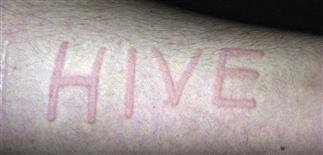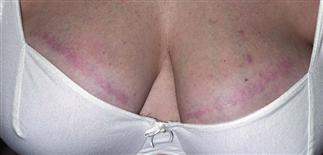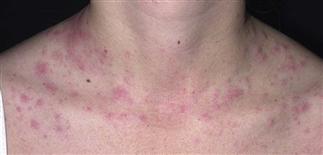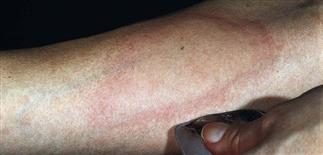26
Physical urticaria

Stroke the skin of any patient complaining of hives. Most patients with dermographism will form a wheal and red flare minutes later. This establishes the diagnosis. No other tests are required.

Pressure urticaria. Swelling may occur hours after the application of pressure. Many patients with chronic urticaria also have pressure urticaria. Antihistamines may not be effective.

Cholinergic urticaria. Round papular wheals occur shortly after exercise or exposure to heat. These ‘heat bumps’ are very common in young adults.

Cold urticaria. Application of a solid or fluid cold stimulus to the skin produces swelling. Swimming in cold water can result in massive swelling and may be dangerous.
DESCRIPTION
Physical urticaria is produced by various physical stimuli and is common in young adults. Dermographism (‘skin writing’) and cholinergic urticaria (‘heat bumps’) are the most common forms.
HISTORY
• Dermographism. Occurs in about 5% of the population. Infections or antibiotics may trigger the disease. It lasts for weeks, months, or years. Recurrences occur. • Pressure urticaria. Deep itchy or painful swellings that occur a few hours after the application of pressure. The disease lasts for years. Many of these patients also have chronic urticaria. Lesions can be induced by standing or walking. • Cholinergic urticaria. Seen in young people and very common. Occurs within 1–20 min of exercise or from exposure to heat; gone in less than 30 min. • Cold urticaria. Occurs in children and young adults. Occurs within minutes of exposure to cold water or cold objects; lasts about 30 min. Swimming in cold water can initiate a massive, dangerous flare.
PHYSICAL FINDINGS
• Dermographism. Shows linear swelling in areas that are scratched. Many patients who complain of itching are dermographic. Streak the arm as a diagnostic test. Linear welts occur in minutes. Patients may have linear hives and typical round hives. • Pressure urticaria. Occurs on the feet, trunk, and buttock from sitting, and presents as broad-based areas of swelling. • Cholinergic urticaria. Heat bumps are round, tiny wheals that may become confluent and look like typical hives.
TREATMENT
The goal of treatment is to relieve symptoms. It is not necessary or possible to completely eliminate the hives or physical urticaria. • Dermographism. Controlled with non-sedating antihistamines such as fexofenadine (Allegra 180 mg) during the day and hydroxyzine 10–25 mg q.h.s. Many patients can be treated for 24 h with a single or b.i.d. dose of hydroxyzine. Patients adapt to hydroxyzine and may not experience sedation after a few days of treatment. Chronic suppression may be required. • Pressure urticaria. Most patients do not require treatment. Some are disabled by the disease and respond to intermittent courses of prednisone. • Cholinergic urticaria. Patients may have to limit exercise. Pretreatment before exercise with cetirizine (Zyrtec 10 mg) or hydroxyzine (10, 25, 50 mg) may help. • Cold urticaria. Patients should avoid sudden changes in temperatures. Immersion in cold water is avoided. Cyproheptadine 4 mg (Pericatin), loratadine 10 mg (Claritin), and cetirizine 10 mg (Zyrtec) may be effective.







